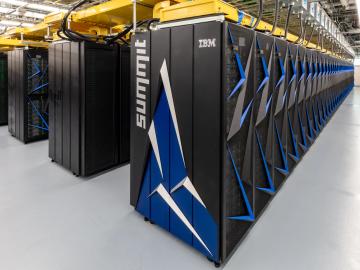
Filter News
Area of Research
- Advanced Manufacturing (1)
- Biological Systems (1)
- Biology and Environment (26)
- Clean Energy (33)
- Climate and Environmental Systems (1)
- Computational Biology (1)
- Computer Science (1)
- Fusion and Fission (7)
- Fusion Energy (1)
- Isotopes (7)
- Materials (16)
- Materials for Computing (4)
- National Security (4)
- Neutron Science (12)
- Nuclear Science and Technology (3)
- Quantum information Science (2)
- Supercomputing (23)
News Type
News Topics
- 3-D Printing/Advanced Manufacturing (9)
- Advanced Reactors (2)
- Artificial Intelligence (8)
- Big Data (3)
- Bioenergy (13)
- Biology (14)
- Biomedical (8)
- Biotechnology (4)
- Buildings (2)
- Chemical Sciences (2)
- Clean Water (5)
- Climate Change (3)
- Computer Science (25)
- Coronavirus (2)
- Cybersecurity (1)
- Decarbonization (3)
- Energy Storage (8)
- Environment (29)
- Exascale Computing (3)
- Frontier (1)
- Fusion (1)
- Grid (2)
- High-Performance Computing (9)
- Isotopes (6)
- ITER (1)
- Machine Learning (1)
- Materials (4)
- Materials Science (7)
- Mercury (4)
- Microscopy (3)
- Nanotechnology (4)
- National Security (4)
- Neutron Science (10)
- Nuclear Energy (9)
- Physics (3)
- Polymers (1)
- Quantum Computing (1)
- Quantum Science (6)
- Security (2)
- Space Exploration (2)
- Summit (8)
- Sustainable Energy (8)
- Transportation (9)
Media Contacts

From the helm of a one-of-a-kind organization that brings nuclear fusion and fission expertise together to pave the way to expanding carbon-free energy, Kathy McCarthy can trace the first step of her engineering career back to

The ExOne Company, the global leader in industrial sand and metal 3D printers using binder jetting technology, announced it has reached a commercial license agreement with Oak Ridge National Laboratory to 3D print parts in aluminum-infiltrated boron carbide.

Since the 1930s, scientists have been using particle accelerators to gain insights into the structure of matter and the laws of physics that govern our world.

As Hurricane Dorian raged through the Bahamas, researchers at Oak Ridge National Laboratory worked around the clock to aid recovery efforts for one of the Caribbean’s worst storms ever.

As program manager for the Department of Energy’s Oak Ridge National Laboratory’s Package Testing Program, Oscar Martinez enjoys finding and fixing technical issues.

This round-up of ten of the most-read news stories from Oak Ridge National Laboratory in 2019 showcases the diversity of the lab’s scientific and engineering research portfolio.

For nearly three decades, scientists and engineers across the globe have worked on the Square Kilometre Array (SKA), a project focused on designing and building the world’s largest radio telescope. Although the SKA will collect enormous amounts of precise astronomical data in record time, scientific breakthroughs will only be possible with systems able to efficiently process that data.
Ancient Greeks imagined that everything in the natural world came from their goddess Physis; her name is the source of the word physics.

Illustration of the optimized zeolite catalyst, or NbAlS-1, which enables a highly efficient chemical reaction to create butene, a renewable source of energy, without expending high amounts of energy for the conversion. Credit: Jill Hemman, Oak Ridge National Laboratory/U.S. Dept. of Energy

While Tsouris’ water research is diverse in scope, its fundamentals are based on basic science principles that remain largely unchanged, particularly in a mature field like chemical engineering.


